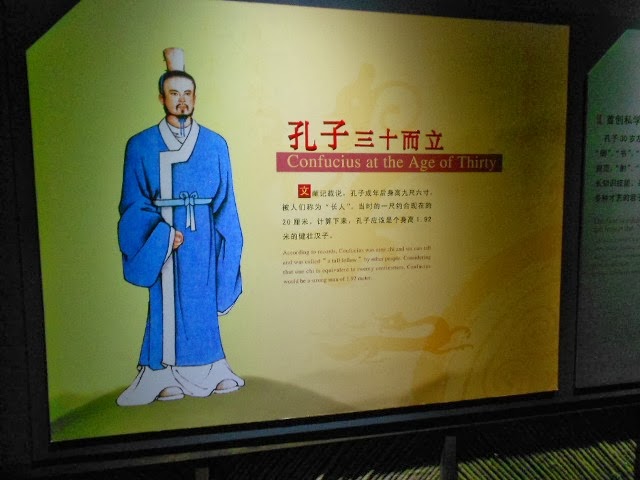Last weekend I went to a nearby site and while I will write a few of my own observations,
The Lonely Planet managed to offer such a good description that I thought I would repeat it here
with attribution:
An incense stick's toss away from the Lama Temple, the desiccated Confucius Temple had a pre-Olympics spruce up that failed to shift its indelible sense of otherworldly detachment. Like all Confucian shrines, China's second-largest Confucian temple feels rather like a mausoleum, so expect peace and quiet. Some of Běijīng's last remaining páilóu bravely survive in the hútòng outside (Guozijian Jie) while antediluvian bìxì (tortoise-like dragons) glare inscrutably from repainted pavilions. Lumpy and ossified ancient cypresses claw stiffly at the sky while at the rear a numbing forest of 190 stelae (stones or slabs etched with figures or inscriptions) records the 13 Confucian classics in 630,000 Chinese characters.
A ghastly footnote lies unrecorded behind the tourist blurb. Běijīng writer Lao She was dragged here in August 1966, forced to his knees in front of a bonfire of Běijīng opera costumes to confess his 'antirevolutionary crimes', and beaten. The much-loved writer drowned himself the next day in Taiping Lake.
West of the Confucius Temple is the Imperial College (国子监; Guózǐjiàn), where the emperor expounded the Confucian classics to an audience of thousands of kneeling students, professors and court officials – an annual rite. Built by the grandson of Kublai Khan in 1306, the former college was the supreme academy during the Yuan, Ming and Qing dynasties. On the site is a marvellous [sic] glazed, three-gate, single-eaved decorative archway. The Bìyōng Hall beyond is a twin-roofed structure with yellow tiles surrounded by a moat and topped with a shimmering gold knob.
I did not know about
Lao She's trial here, but beyond this interesting tidbit, I found the appraisal accurate and the language vivid.
 |
| The first statue of Confucius that one sees upon entering the shrine. |
 |
| Halberds at the gate to the temple. |
 |
| Caption in the museum reads, "According to the records, Confucius was nine chi and six cun tall and was called 'a tall fellow' by other people. Considering that one chi is equivalent to twenty centimeters, Confucius would be a strong man of 1.92 cm." This was only the tip of the iceberg in his glorification. |
 |
This is one of the hundreds of 190 stelae that the Emperor Qianlong, who reigned during
the time of the American Revolution, had inscribed with 13 classic books. I liked the
stone of this one, with its mottled, China-like surface.
|
 |
| Just before I took this beautiful picture, I had a wonderful conversation with a blustery German fellow and his Chinese wife, who were tourists from the Vancouver area, but there were not a ton of people around so it was much like Lonely Planet describes--a place where you can "expect peace and quiet." |
 |
| Another statue of the great sage, Kongzi (孔子), fenced in with the red-ribbons of good wishes |
 |
| A couple of large mythical beasts seem ready to devour the HVAC system, perhaps to preserve the blue-sky days. |
 |
| The lovely second story of a hutong (alleyway) home that has a straight view of the temple's grounds. |
 |
| "What? You did not do your homework?!" |
The dorms of the scholars seemingly used a system of movable boards to transform their cells from beds into study chambers or an eating table.
 |
The azure heavens with the celadon and golden ceramics that adorn the tomato soup red stone gate made for a gorgeous picture. "Gnarled cypress trees outside the gate create thick shade from the sun. On each side of the gate stands a huge marble stele inscribed in Mandarin and Mongolian ordering all horse riders, even the emperor, to dismount. The glazed yellow tiles on the roof reveal the temple’s past dignity." (from CITS) |













No comments:
Post a Comment
You are encouraged to leave your two cents.